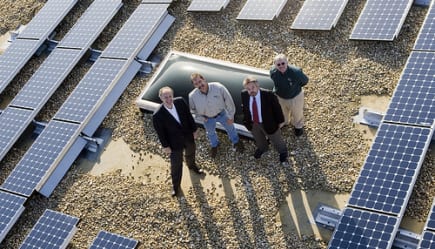Microgrids, by all accounts I’ve seen, are projected to increase considerably in the coming years. There are several good reasons for that, including more reliable electricity, more secure electricity, and assistance in integrating renewable energy into the grid.
One of the first commercial-scale microgrids in the US has just been completed, showing others how it could (and should) be done. In a press release published earlier this week, Standard Solar and Solar Grid storage wrote: “Standard Solar, a leader in the full-service development, construction, integration, financing and installation of solar electric systems, in collaboration with Solar Grid Storage, today announced that construction is complete on the solar microgrid project at Maryland-developer Konterra’s headquarters. The project, announced earlier this year, is a grid-interactive energy storage system co-located with a new 1,368 panel photovoltaic (PV) array.”
Here are some more details from the release:
The project is financed by Konterra, PNC Bank and Solar Grid Storage and supported through a Maryland Energy Administration (MEA) “Game Changer” Grant. Konterra is designed to be a sustainable mixed-use community in which healthy working and living environments incorporate innovative technologies and renewable energy solutions. With Maryland’s first commercial solar microgrid installation at its headquarters Konterra will reduce its use of non-renewable natural resources, while also providing stability to the grid and backup power to its building during outages.
The innovative system is powered by a 402kW solar PV array that not only produces clean electricity but can also provide new benefits such as backup emergency power, demand reduction and peak shaving. In the event of a grid power outage, the Solar Grid Storage advanced energy storage system allows critical circuits at Konterra to remain energized.
The system can also enhance grid reliability by helping balance the grid through frequency regulation, volt-ampere reactive (VARs) compensation, and demand response services. According to Navigant Research, more than 1,300 gigawatts (GW) of wind and solar power generation capacity are expected to come online in the next 10 years. Widespread adoption of micro-grids will ensure that this huge increase in solar and wind power is effectively integrated into the national utility grid.
Not bad. Overall, Maryland has been doing better than average in advancing its solar industry. Based on end-of-2012 numbers, Maryland is the 12th-best US state for solar power per capita. For new solar power capacity added in 2012, it was #10. However, a ranking of state solar and electricity policies created by Solar Power Rocks actually put Maryland at #2, so perhaps it will continue to climb up the rankings.
Highlighting Maryland’s solar power growth in the midst of the announcement above, Governor Martin O’Malley said: “Our better choices to invest in clean energy have paid off. In Maryland, by making solar energy a priority, we went from approximately zero to nearly 1,319 times more solar on the state’s grid as well as 2,000 more solar installation jobs than in 2007. We’ve set some of the most aggressive goals in the country for reducing our energy consumption, and increasing our use of renewable energy. Solar energy will diversify our energy portfolio and make us a leader in sustainable energy development.” Here’s hoping for more and more of it!
Source: Clean Technica. Reproduced with permission.










